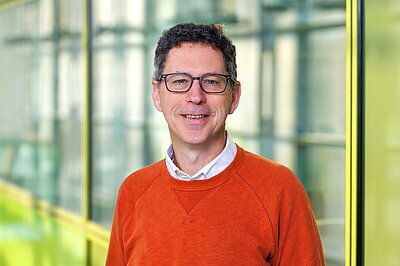Launching a New Lab to Unveil the Origin of Eukaryotic Life
In March of this year, the Austrian Science Fund (FWF) awarded an Emerging Fields Grant to EvoChromo, a collaborative Vienna-based project between the labs of Frédéric Berger at the GMI, Christa Schleper at the University of Vienna and Florian Schur at the Institute of Science and Technology Austria (ISTA). The project will create a new multidisciplinary, decentralized laboratory to study chromatin evolution in Asgards.
But what is a decentralized laboratory? And how did this collaboration come to be? And more importantly, what is an Asgard? We sat down with Frédéric Berger, coordinator of EvoChromo and Senior Group Leader at the GMI, to learn more about this fascinating project.
EvoChromo’s objective is to study the evolutionary origin of chromatin proteins, which organize and package the DNA in the chromosomes of all eukaryotes. Our project aims to study when and how chromatin proteins first evolved from prokaryotic building blocks. For this, we will use a fascinating model, the Asgard species Lokiarchaeum ossiferum, or Loki for short.
Asgard archaea represent our closest known prokaryotic relatives. Indeed, Asgards present many features that forecast what happened during eukaryotic evolution, including complex processes such as the organization of the cytoskeleton. More importantly, the proteins involved in such processes resemble those found in eukaryotes.
However, Asgards have barely been studied. Asgards were first identified in 2015 and only two cultures are available worldwide. In particular, the Asgard model Loki was first identified and cultured by Christa Schleper at the University of Vienna. We and others suspect that many of the proteins previously thought to be eukaryote-specific, or their evolutionary precursors, are present in Asgards, which would change the way we understand the evolution of eukaryotic life forms.
I have always been interested in studying the evolution of chromatin, especially the origin of chromatin proteins. I realized that studying more primitive eukaryotes would not provide the answers I was looking for, and then I found literature that mentioned that some of the building blocks for eukaryotic proteins were already present in prokaryotes. I realized that Christa Schleper, one of the world’s greatest specialists on Asgards, worked literally next door to the GMI. So, I contacted Christa and we talked about her research on Asgards and came up with the idea for this collaboration. Almost immediately, we realized that we would need to recruit an expert in cryo-tomography, so we contacted Florian Schur at ISTA and asked him to join us in this project.
Ultimately, this collaboration brings together three large research hubs in Vienna, making the whole project very ambitious and transversal and highlighting the quality of research being performed in Vienna.
Drafting this proposal was a challenge. Not only do we have very different research profiles, but we had not even met in person before this all started! Once we agreed on going forward with the project, we spent a month drafting the application for the Emerging Fields Grant from the Austrian Science Fund. Both Christa and Florian were extremely helpful in this process and contributed their different expertise and know-how to design an attractive proposal.
The Emerging Fields Grant is a fantastic initiative by the Excellent=Austria program from the Austrian Science Fund, which provides substantial funding. The program funds projects that aim to tackle new and important questions in any field of research. The funding from the Austrian Science Fund will support the creation of a new decentralized lab called EvoChromo, which will combine the scientists and expertise of the three participating research groups.
This lab will work in an unorthodox way: the three group leaders (Christa, Florian and myself) will share the project leadership, and group members will be involved in the research and overlap between the different research institutions. This model will allow us to interact closely and learn from each other while contributing our different expertise from an equal standing. This new way of doing science promoted by the Emerging Fields initiative is an exciting change of pace for our labs.
This project and new model organism will bring on a significant transition, as we will have to develop new protocols and workflows adapted to working with data from Asgards. Due to the limited biomass that Asgard cultures can produce, we will have to reinvent our approaches and expand our experience to synthetic biology. Recruiting new members who can bring different expertise will be essential to developing this project. While this is a big shift in the lab’s direction, it is not the first time my group has experienced such a change, and I have found each instance to be very rewarding. I look forward to the new experiences this project will bring and the discoveries that will arise from it!
